Martienssen W., Warlimont H. (Eds.). Handbook of Condensed Matter and Materials Data
Подождите немного. Документ загружается.


762 Part 4 Functional Materials
Table 4.3-11 Magnetic properties of sintered Fe
−
Co products in relation to density
a
[3.10]
Density Coercitivity Remanence Sat. induction Max. rel. permeability
(gcm
−3
) H
c
(Am
−1
) B
r
(T) B
s
(T) µ
max
7.9
b
136
b
1.10
b
2.25
b
3900
b
a
Measured according to ASTM A 596
b
Fe/47–50 wt% Co/1–3 wt% V
Table 4.3-12 Magnetic properties of composite Fe products in relation to density and insulation [3.10]
Density Insulation Curing Coercitivity Induction at Max. rel. permeability
(gcm
−3
) (
◦
C) (min) H
c
(Am
−1
) 3183 A m
−1
(T) µ
max
5.7–7.26 Polymer 263–374 0.33–0.83 97–245
7.2 Oxide + 0.75 Polymer 374 0.77 210
7.4–7.45 0.75–0.6 % Polymer 381–374 1.09–1.12 400–425
7.54 Oxide 630
7.04 Inorganic (LCM
TM
) 305
7.0 0.5 % Phenolic resin
a
150, 60 400 270
7.13–6.84
b
0.4–1.8 % Phenolic
a
160.30 325–175
c
7.2
b
0.8 % Phenolic
a
150–500.30 445–310 270–390
6.6 3 % resin 200
6.7–7.0 Inorganic & 2 % resin ?–500 200–400
7.4 Inorganic (Somaloy
TM
500) 500 600
a
Dry Mixing or wet mixing with phenolic resin
b
Compacted at 620 MPa and 65
◦
C
c
AC permeability at 60 Hz and 1.0T
Table 4.3-13 Core loss of composite Fe products in relation to lubricant and heat treatment [3.10]
Lubricant Heat treatment Density Total loss at Total loss at
(
◦
C) (min.) (Atm.) (g cm
−3
) 100 Hz, 1.5T(Wkg
−1
) 1000 Hz, 1.5T(Wkg
−1
)
0.1 % Kenolube
TM d
500 30 air 7.40
b
29
0.5 % Kenolube
TM
500 30 air 7.20
a
32 450
0.5–0.8 % Kenolube
TM
500 30 air 7.36–7.26
b
29–31 330–450
0.5 % Kenolube
TM
500 30 nitrogen 7.35
b
31 350
0.5 % Kenolube
TM
250–580 30 steam 7.35
b
30–70
0.6 % LBI
TM
275 60 air 7.27
b
700
0.5 % Kenolube
TM
500 30 air 7.20
a
35 480
0.5 % Kenolube
TM
500 30 air 7.34
a
34 420
a
Conventional compacting at 600MPa
b
Conventional compacting at 800MPa
Water atomized iron powder, particle size > 150 µm < 400 µm, low inorganic insulation thickness, (Somatoy
TM
550)
Part 4 3.2
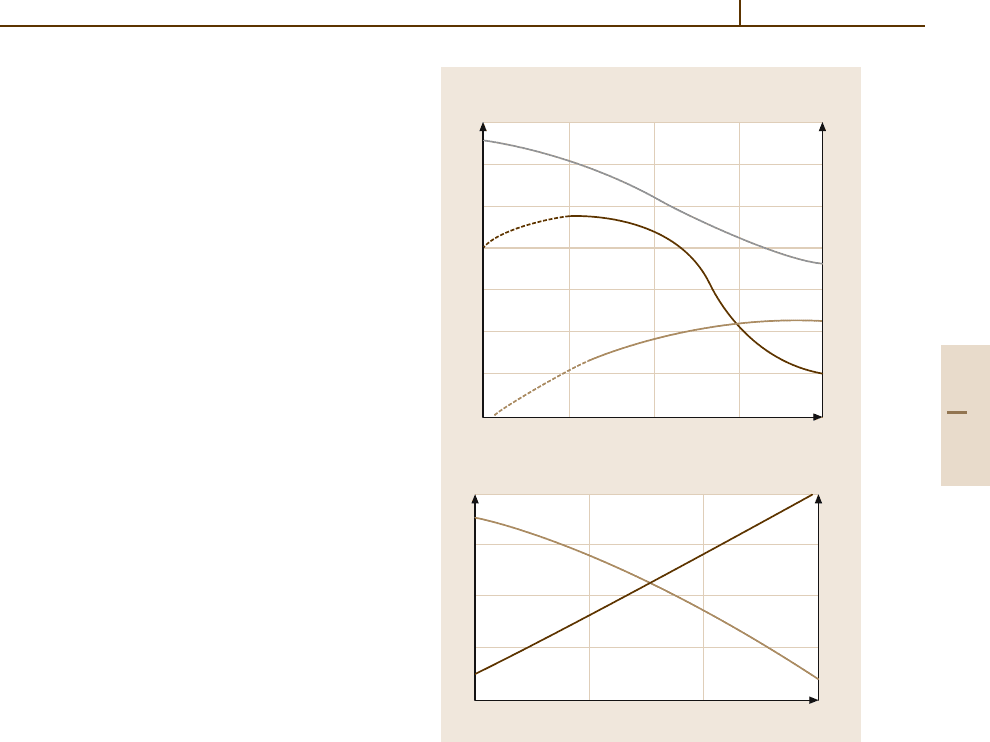
Magnetic Materials 3.2 Soft Magnetic Alloys 763
4.3.2.3 Iron–Silicon Alloys
The physical basis of the use of Fe
−
Si alloys, commonly
called silicon steels, as soft magnetic materials is the fact
that both the magnetocrystalline anisotropy K
1
and the
magnetostriction parameters λ
100
and λ
111
of Fe ap-
proach zero with increasing Si content (see Fig. 4.3-5a).
The lower the magnitude of these two intrinsic magnetic
properties is, the lower are the coercivity H
c
and the AC
magnetic losses p
Fe
. The total losses p
Fe
consist of the
static hysteresis losses p
h
and the dynamic eddy current
losses p
w
which may be subdivided into a classical p
wc
and an anomalous p
wa
eddy current loss term,
p
Fe
= p
h
+ p
wc
+ p
wa
= c
h
( f )H
c
Bf
+c
wc
(πdB f )
2
/6ργ +c
wa
(α
R
/ρ)(Bf)
3/2
,
where c
h
( f ) is a form factor of the hysteresis which
depends on the frequency f , H
c
is the coercivity of the
material, B is the peak operating induction, c
wc
and c
wa
are terms taking the wave form of the applied field into
account, d is the sheet thickness, ρ is the resistivity,
γ is the density of the material, and α
R
is the Raleigh
constant. These are the factors to be controlled to obtain
minimal losses. The increase in electrical resistivity with
Si content (Fig. 4.3-5b) adds to lowering the eddy current
losses as shown by the relation above.
The Fe
−
Si equilibrium diagram shows a very small
stability range of the γ phase, indicating that the fer-
romagnetic α phase can be heat-treated in a wide
temperature range without interference of a phase trans-
formation which would decrease the magnetic softness
of the material by the lattice defects induced.
Next to low-carbon steels, Fe
−
Si steels are the most
significant group of soft magnetic materials (30% of
the world market). A differentiation is made between
non-oriented, isotropic (NO), and grain-oriented (GO)
silicon steels. Non-oriented steels are mainly applied in
rotating machines where the material is exposed to vary-
ing directions of magnetic flux. Grain-oriented steels
with GOSS-texture (110) 001 are used predominantly
as core material for power transformers.
Since Fe
−
Si steels are brittle above about
4.0 wt% Si, conventional cold rolling is impossible at
higher Si contents.
Non-oriented Silicon Steels (NO)
NO laminations are usually produced with thicknesses
between 0.65 mm and 0.35 mm, and Si concentrations
up to 3.5 wt%. According to their grade, NO silicon
50
40
30
20
10
0
–10
–20
Magnetostriction
50
40
30
20
10
0
Si-content (wt%)
Fe 2 4 6 8
80
60
40
20
0
2.2
2.1
2.0
1.9
1.8
0246
Silicon content (wt%)
λ
(×10
–6
)
Crystalline anistropy
K
1
(kJ m
–3
)
a)
K
1
λ
100
λ
111
b)
Resistivity ρ
10
–8
Ωm
Polarization I
s
I
s
ρ
Fig. 4.3-5 (a) Magnetostriction λ
100
and λ
111
and
magneto-crystalline anisotropy energy K
1
. (b) Electrical
resistivity ρ and saturation polarization I
s
, as a function of
the Si content in Fe
−
Si alloys
steels are classified in low grade (low Si content) alloys
employed in small devices and high-grade (high Si con-
tent) alloys for large machines (motors and generators).
Suitable microstructural features (optimum grain size)
and a low level of impurities are necessary for optimum
magnetic properties. Critical factors in processing are
the mechanical behavior upon punching of laminations,
the application of insulating coatings, and the build-up of
stresses in magnetic cores. Table 4.3-14 lists the ranges
of typical processing parameters.
In the case of low Si steels (< 1 wt% Si), the last two
annealing steps are applied by the user after lamination
punching (semi-finished sheet). Table 4.3-15 lists the
specifications, including all relevant properties for non-
oriented magnetic steel sheet.
Part 4 3.2
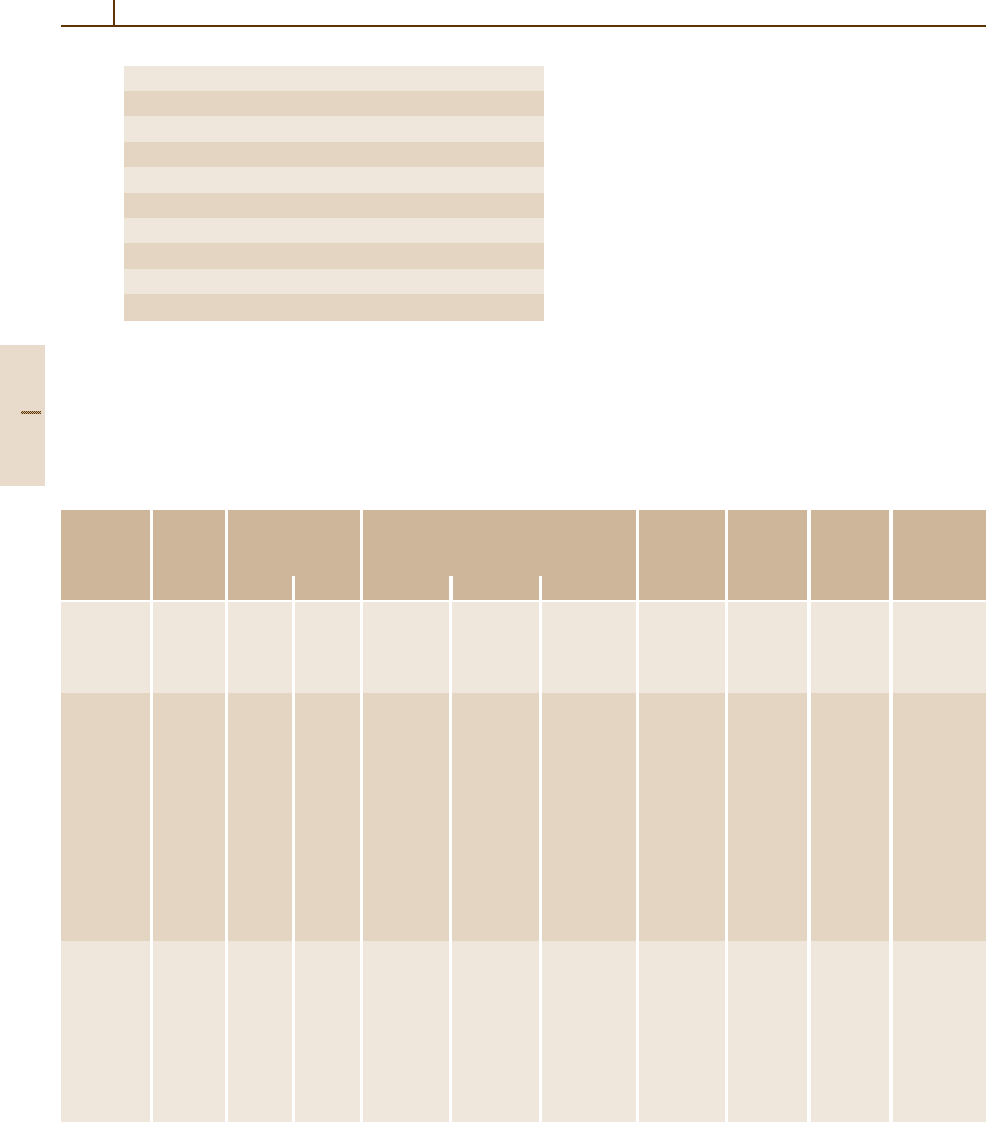
764 Part 4 Functional Materials
Composition (wt%) Si: 0.9–3.4, Al: 0.2–0.6, Mn: 0.1–0.3
Melting, degassing, continous casting
Hot rolling to 1.8–2.3 mm (1000–1250
◦
C)
Cold rolling to intermediate gauge
Annealing (750–900
◦
C)
Cold rolling to final gauge (0.65–0.35 mm)
Decarburizing anneal (830–900
◦
C, wet H
2
)
Recrystallization
Grain growth anneal (830–1100
◦
C)
Coating
Table 4.3-14 Schematic of NO silicon steel processing.
Addition of small quantities (50–800 wt ppm) of Sb, Sn,
or rare earth metals can be made to improve texture and/or
control the morphology of the precipitates. Cold reduction
in a single stage repesents a basic variant of the above
scheme. The final grain growth annealing aims at an
optimum grain size, leading to minimum losses. Coating
provides the necessary interlaminar electrial insulation.
Phosphate- or chromate-based coatings are applied, which
ensure good lamination punchability [3.7]
Table 4.3-15 Standard IEC specification for nonoriented magnetic steel sheet delivered in the final sate. The conventional
designation of the different grades comprises the following order (first column): (1) 100 times the maximum specified loss at
1.5 T peak induction in (W kg
−1
); (2) 100 times the nominal sheet thickness; (3) the characteristic letter “A”; (4) one tenth of the
frequency in Hz, at which the magnetic properties are specified. The anisotropy of loss, T , is specified at 1.5 T peak induction
according to the formula T = (P
1
− P
2
)/(P
1
+ P
2
)100, with P
1
and P
2
the power losses of samples cut perpendicular and parallel
to the rolling direction, respectively [3.7]
Quality Nominal Maximum specific Minimum magnetic flux density (T) Maximum Minimum Minimum Conven-
thickness total loss (W kg
−1
) in direct or alternating field at field anisotropy stacking number tional
(mm) at peak induction strength of loss (%) factor of bends density
1.5T 1.0T 2500 Am
−1
5000 Am
−1
10 000 Am
−1
(10
3
kg m
−3
)
250-35-A5 0.35 2.50 1.00 1.49 1.60 1.71 2 7.60
270-35-A5
0.35 2.70 1.10 1.49 1.60 1.71 ±18 0.95 2 7.65
300-35-A5
0.35 3.00 1.20 1.49 1.60 1.71 3 7.65
330-35-A5
0.35 3.30 1.30 1.49 1.60 1.71 3 7.65
270-50-A5 0.50 2.70 1.10 1.49 1.60 1.71 2 7.60
290-50-A5
0.50 2.90 1.15 1.49 1.60 1.71 ±18 2 7.60
310-50-A5
0.50 3.10 1.25 1.49 1.60 1.71 3 7.65
330-50-A5
0.50 3.30 1.35 1.49 1.60 1.71 ±14 3 7.65
350-50-A5
0.50 3.50 1.50 1.50 1.60 1.71 5 7.65
400-50-A5
0.50 4.00 1.70 1.51 1.61 1.72 0.97 5 7.65
470-50-A5
0.50 4.70 2.00 1.52 1.62 1.73 7.70
530-50-A5
0.50 5.30 2.30 1.54 1.64 1.75 7.70
600-50-A5
0.50 6.00 2.60 1.55 1.65 1.76 ±12 10 7.75
700-50-A5
0.50 7.00 3.00 1.58 1.68 1.76 7.80
800-50-A5
0.50 8.00 3.60 1.58 1.68 1.78 7.80
350-65-A5 0.65 3.50 1.50 1.49 1.60 1.71 2 7.65
400-65-A5
0.65 4.00 1.70 1.50 1.60 1.71 2 7.65
470-65-A5
0.65 4.70 2.00 1.51 1.61 1.72 ±14 5 7.65
530-65-A5
0.65 5.30 2.30 1.52 1.62 1.73 0.97 5 7.70
600-65-A5
0.65 6.00 2.60 1.54 1.64 1.75 7.75
700-65-A5
0.65 7.00 3.00 1.55 1.65 1.76 ±12 10 7.75
800-65-A5
0.65 8.00 3.60 1.58 1.68 1.76 7.80
1000-65-A5
0.65 10.00 4.40 1.58 1.68 1.78 7.80
Part 4 3.2
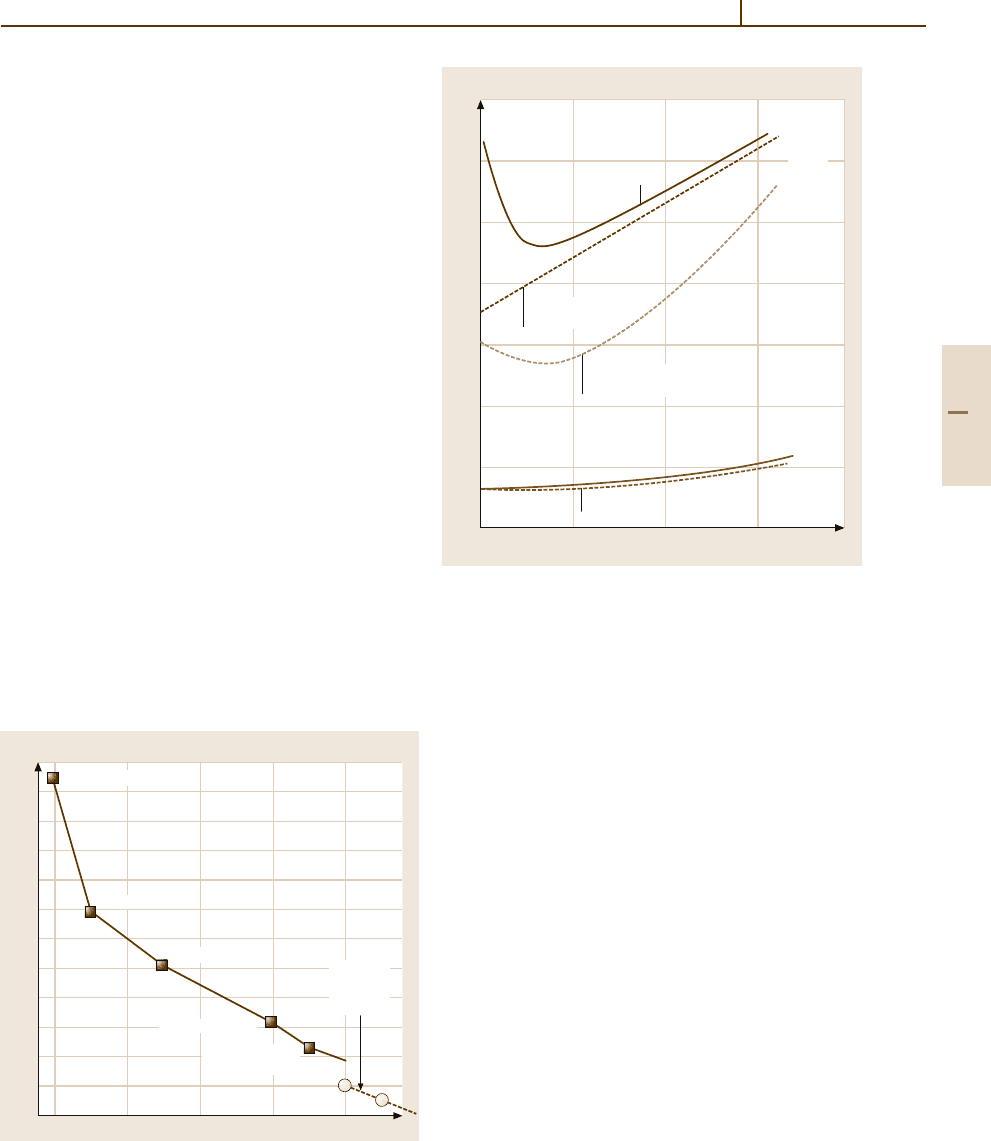
Magnetic Materials 3.2 Soft Magnetic Alloys 765
Grain-Oriented Silicon Steels (GO)
Grain-oriented (GO) silicon steel is used mainly as core
material for power transformers. Worldwide production
is about 1.5 million tonsper year. The increasing demand
for energy-efficient transformers requiring still lower
loss materials has led to continuous improvements of
the magnetic properties over the years, where a decrease
in the deviation from the ideal Goss texture (110)[001]
has played a decisive role. Moreover, the eddy current
losses have been reduced by decreasing the lamination
thickness from 0.35 mm through 0.30 mm and 0.27 mm
to 0.23 mm. Surface treatments of the laminations by
mechanical scratching or laser scribing have been intro-
duced. They increase the number of mobile Bloch walls
and, thus, decrease the spacing between them, i. e., the
domain size. Accordingly, the anomalous eddy current
losses were reduced. The reduction of the total losses of
grain oriented electrical steel due to these improvements
is illustrated in Fig. 4.3-6.
The GO steels are classified in two categories: con-
ventional grain-oriented (CGO) and high permeability
(HGO) steels. The latter are characterized by a sharp
crystallographic texture, with average misorientation of
the [001] axes of the individual crystallites around the
rolling direction (RD) on the order of 3
◦
. For CGO the
misorientation is about 7
◦
. The relation between the an-
gular deviation of grain orientation and the total loss
reduction for HGO material is shown in Fig. 4.3-7.
1.8
1.6
1.4
1.2
1.0
0.8
0.6
1960 1970 1980 1990 2000
Loss P
1.7
(Wkg
–1
)
CGo 0.35 mm
CGO 0.27 mm
HGO 0.30 mm
New
develop-
ments
HGO 0.23 mm
HGO 0.23 mm
Laser scribed
Fig. 4.3-6 Qualitative improvment of GO electrical
steel [3.11]
1.4
1.2
1.0
0.8
0.6
0.4
0.2
0
0° 2° 4° 6° 8°
Misorientation angle
Hysteresis and total loss (Wkg
–1
)
Total
loss
Without
With domain
refinement
With domain
refinement and tension
Hysteresis loss
B
ˆ
= 1.5 T
f = 50 Hz
Fig. 4.3-7 Relation between grain orientation and power
loss reduction for highly grain-oriented material (single
crystal) (Bölling and Hastenrath) [3.12,13]
The (GO) manufacturing route is an extraordinarily
long sequence of hot and cold processing steps. The
final magnetic properties are highly sensitive to even
small parameter variations throughout this route. Some
of these processes, their microstructure, and the inhibitor
element influence are given in Table 4.3-16.
A key factor is the controlled development of the
(110)[001] texture during secondary recrystallization. It
requires the presence of large Goss textured grains in
the surface layers of the annealed hot band, the presence
of inhibitors as finely dispersed second-phase particles
which strongly impede normal grain growth during
primary recrystallization and a primary recrystallized
texture having a suitable orientation relationship with re-
spect to the Goss texture. This can be obtained through
carefully-controlled chemistry and a precisely-defined
sequence of thermomechanical treatments. Abnormal
grain growth during secondary recrystallization may in-
crease the size of magnetic domains and consequently
greater energy dissipation under dynamic conditions.
Refining the domain structure by laser or mechanical
scribing core as mentioned above reduces the losses.
Standard IEC specifications for grain-oriented magnetic
Part 4 3.2
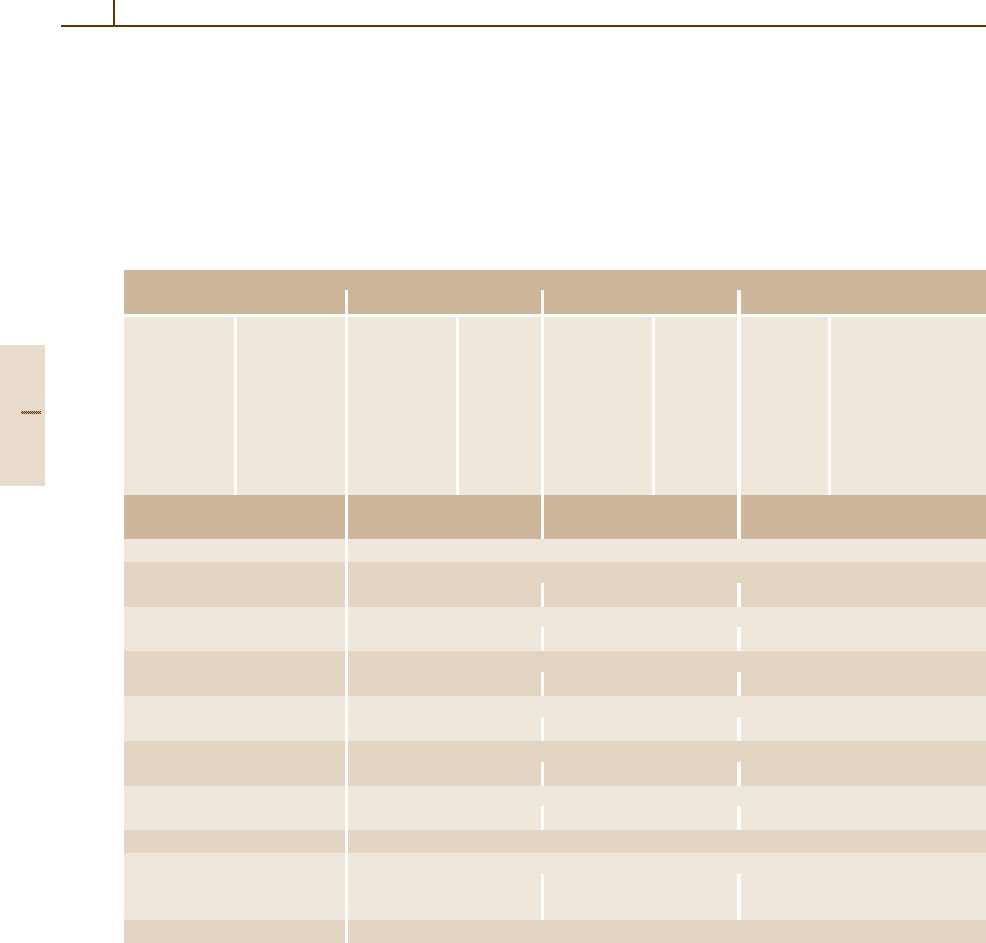
766 Part 4 Functional Materials
Table 4.3-16 Summary of the processing of grain-oriented silicon steel. The first column relates to the conven-
tional grain-oriented (CGO) laminations. Process for three different types of high permeability (HGO) steels are
outlined in columns 2–4. They basically differ for the type of grain growth inhibitors, the cold-rolling sequence,
and the annealing temperatures. The processes CGO and HGO-1 adopt a two-stage cold reduction, with inter-
mediate annealing, while HGO-2 and HGO-3 steels are reduced to the final thickness in a single step. Growth
inhibition of the primary recrystallized grains is obtained by MnS precipitates in the CGO process. MnSe par-
ticles + solute Sb operate in process HGO-1, MnS +AlN particles in HGO-2, and solute B + N + S in HGO-3.
Abnormal growth of (110)[001] grains occurs by final box annealing, which also promotes the dissolution of the
precipitates [3.7]
Type of Steel
CGO
HGO-1 HGO-2 HGO-3
Composition (wt%)
3–3.2 Si 2.9–3.3 Si 2.9–3.3 Si 3.1–3.3 Si
0.04–0.1
Mn 0.05 Mn 0.03 Al 0.02 Mn
0.02
S 0.02 Se 0.015 N 0.02 S
0.03
C 0.04 Sb 0.07 Mn 0.001 B
balance
Fe 0.03–0.07 C 0.03 S 0.005 N
balance Fe 0.05–0.07 C 0.03–0.05 C
balance Fe balance Fe
Inhibitors
MnS MnSe + Sb MnS + AlN B + N + S
Melting, degassing and continuous casting
Reheating - hot rolling
1320
◦
C 1320
◦
C 1360
◦
C 1250
◦
C
Annealing
800–1000
◦
C 900
◦
C 1100
◦
C 870–1020
◦
C
Cold rolling
70 %
60–70 % 87 % 80 %
Annealing
800–1000
◦
C
Cold rolling
55 % 65 %
Decarburizing anneal
800–850
◦
C (wet H
2
)
MgO coating and coiling
Box-annealing
1200
◦
C 820–900
◦
C 1200
◦
C 1200
◦
C
+ 1200
◦
C
Phospate coating and thermal flattening
steel sheets are listed in Table 4.3-17. Basic proper-
ties of grain-oriented Fe–3.2 wt% Si alloys are given in
Table 4.3-18.
A recent technology development in the produc-
tion of GO electrical steel is the combination of thin
slab casting, direct hot rolling, and acquired inhibitor
formation. This practice combines the advantages of
low temperatures, process-shortening, microstructural
homogeneity, improved strip geometry, and better
surface condition of the products. The slab thick-
ness is on the order of 50–70 mm. Another future
technology with remarkable process shortening is to
produce (GO) hot strip in the thickness range of about
2–3 mm by direct casting from the steel melt using
a twin-roll casting method. In pilot line tests, good
workability and good magnetic properties have been
achieved.
Further potential for cost and time saving is expected
from replacing box annealing at the end of the cold
process by short-time continuous annealing.
Part 4 3.2
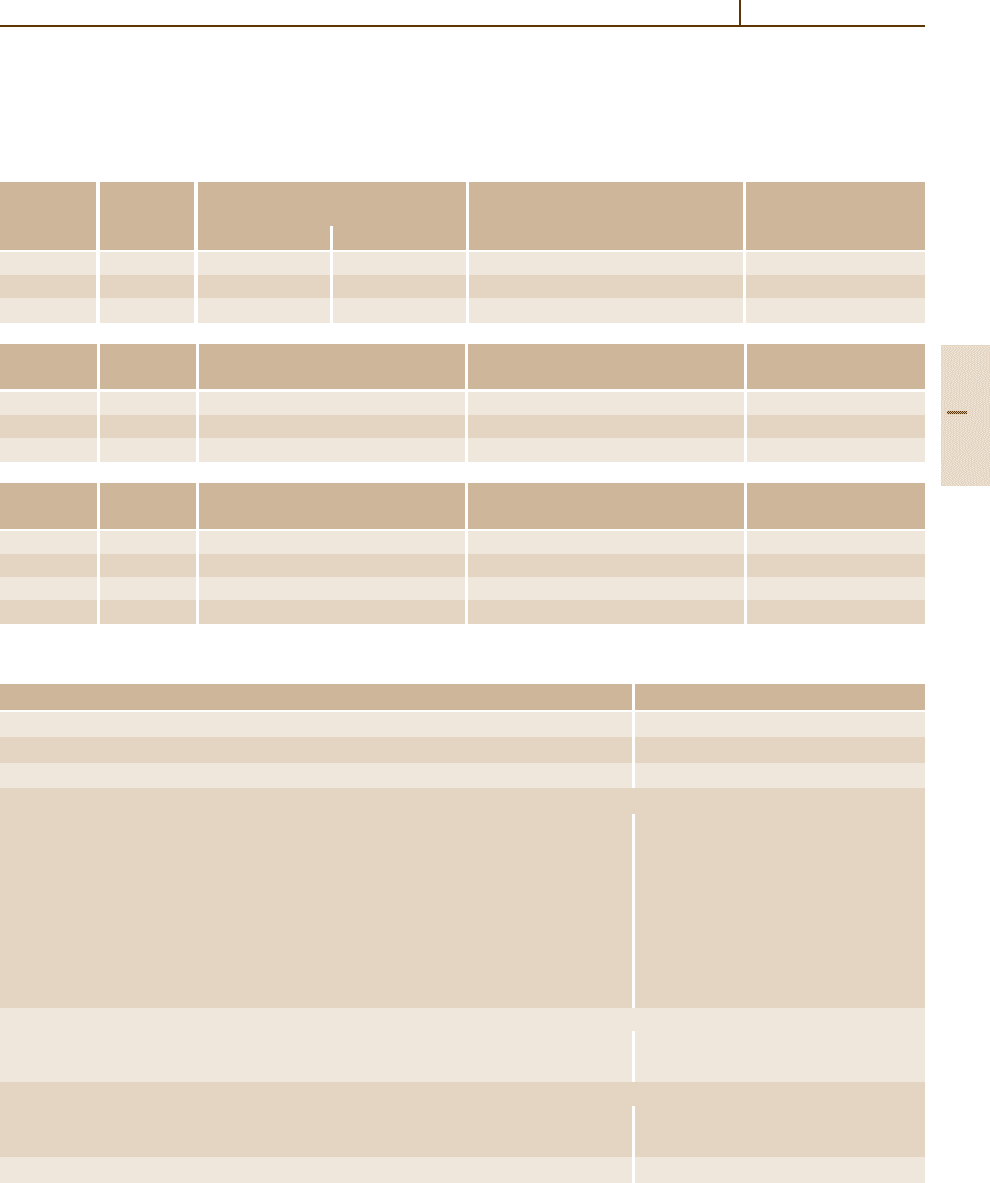
Magnetic Materials 3.2 Soft Magnetic Alloys 767
Table 4.3-17 Standard IEC specification for grain-oriented magnetic steel sheet: (a) normal material; (b) material with reduced
loss; (c) high-permeability material. The conventional designation of the various grades (first column) includes, from left to
right, (1) 100 times the maximum power loss, in (W kg
−1
), at 1.5T(a) or 1.7T(b,c) peak induction; (2) 100 times the nominal
sheet thickness, in (mm); (3) the letter “N” for the nominal material (a), or “S” for material with reduced loss (b),or“P”for
high-permeability material (c); (4) one tenth of the frequency in Hz, at which the magnetic properties are specified [3.7]
a) Grade Thickness Maximum specific total loss Minimum magnetic flux density (T) Minimum stacking
(W kg
−1
) at peak induction for H = 800 Am
−1
factor
(mm) 1.5T 1.7T
089-27-N 5 0.27 0.89 1.40 1.75 0.950
097-30-N 5 0.30 0.97 1.50 1.75 0.955
111-35-N 5 0.35 1.11 1.65 1.75 0.960
b) Grade Thickness Maximum specific total loss Minimum magnetic flux density (T) Minimum stacking
(mm) (W kg
−1
)at1.7 T peak induction for H = 800 Am
−1
factor
130-27-S 5 0.27 1.30 1.78 0.950
140-30-S 5 0.30 1.40 1.78 0.955
155-35-S 5 0.35 1.55 1.78 0.960
c) Grade Thickness Maximum specific total loss Minimum magnetic flux density (T) Minimum stacking
(mm) (W kg
−1
)at1.7 T peak induction for H = 800 Am
−1
factor
111-30-P 5 0.30 1.11 1.85 0.955
117-30-P 5 0.30 1.17 1.85 0.955
125-35-P 5 0.35 1.25 1.85 0.960
135-35-P 5 0.35 1.35 1.85 0.960
Table 4.3-18 Basic properties of grain-oriented Fe–3.2 wt% Si alloys [3.7]
Property Value
Density 7.65× 10
3
kg m
−3
Thermal concuctivity 16.3W
◦
C
−1
kg m
−3
Electrical resistivity 48× 10
−8
Ω m
Young’s modulus
Single crystals
[100] direction 120 GPa
[110] direction
216 GPa
[111] direction
295 GPa
(110)[001] texture
Rolling direction (RD) 122 GPa
45
◦
to RD 236 GPa
90
◦
to RD 200 GPa
Yield strength
(110)[001] texture
Rolling direction 324 MPa
Tensile strength
(110)[001] texture
Rolling direction 345 MPa
Saturation induction 2.0T
Part 4 3.2

768 Part 4 Functional Materials
Table 4.3-18 Basic properties of grain-oriented Fe–3.2 wt% Si alloys [3.7], cont.
Property Value
Curie temperature 745
◦
C
Magnetocrystalline anisotropy 3.6×10
4
Jm
−3
Magnetostriction constants
λ
100
23× 10
−6
λ
111
−4×10
−6
Rapidly Solidified Fe–Si Alloys
The Fe–6.5 wt% Si alloy exhibits good high-frequency
soft magnetic properties due to a favorable combination
of low values of the saturation magnetostriction λ
s
,
as well as the low values of the magnetocrystalline
anisotropy energy K
1
, and a high electrical resistivity.
But as mentioned above, Fe
−
Si alloys which contain
more than about 4 wt% Si are brittle and thin sheets
cannot be manufactured by rolling. Therefore, Fe–
6.5 wt% Si sheets and ribbons are manufactured via
two different routes by which the adverse mechanical
properties are circumvented: a continuous “siliconiz-
ing” process in commercial scale production and a rapid
quenching process.
Table 4.3-19 Physical and magnetic properties of rapidly quenched Fe–6.5 wt% Si alloys [3.7]
Property Value
Density 7.48×10
3
kg m
−3
Thermal conductivity (31
◦
C) 4.5 cal m
−1◦
C
−1
s
−1
Specific heat (31
◦
C) 128 cal
◦
C
−1
kg
−1
Coefficient of thermal expansion (150
◦
C) 11.6×10
−6 ◦
C
−1
Electrical resistivity 82× 10
−8
Ω m
Tensile strength (rapidly-quenched ribbons 60 µm thick) 630 MPa
Saturation magnetization 1.8T
Curie temperature 700
◦
C
Saturation magnetostriction 0.6×10
−6
Table 4.3-20 Magnetic properties of 30–40 µm thick, rapidly-quenched ribbons of Fe–6.5 wt% Si, in the as-quenched
state and after 24 h annealing at various temperatures [3.7]
Annealing temperature (
◦
C) H
c
(A m
−1
) H
10
(T) B
r
/B
10
µ
max
/µ
0
As-quenched 112 1.25 0.70 3100
500 100 1.27 0.93 4300
700 72 1.32 0.90 5400
800 45 1.31 0.92 9400
850 37.5 1.28 0.94 10 000
900 33 1.30 0.77 12 500
1000 21 1.31 0.83 17 000
1100 18 1.30 0.84 18 000
1200 20 1.32 0.87 22 000
In the siliconizing process Fe–3 wt% Si sheet reacts
with a Si-containing gas at 1200
◦
C. The sheet is held
at 1200
◦
C in order to increase and homogenize the Si
content by diffusion. After this treatment the ductility of
Fe–6.5 wt% Si sheets amounts to about 5% elongation
to fracture.
By rapid quenching from the melt, the formation
of the B2 and D0
3
type ordered structures, based on
conventional cooling after casting of Fe–6.5 wt% Si al-
loys, may be suppressed. Thus, the ensuing material
brittleness can be overcome. The ribbons formed by the
rapid quenching process are about 20 to 60 µm thick
and are ductile, with a microcrystalline structure. By
means of an annealing treatment above 1000
◦
Cfol-
Part 4 3.2
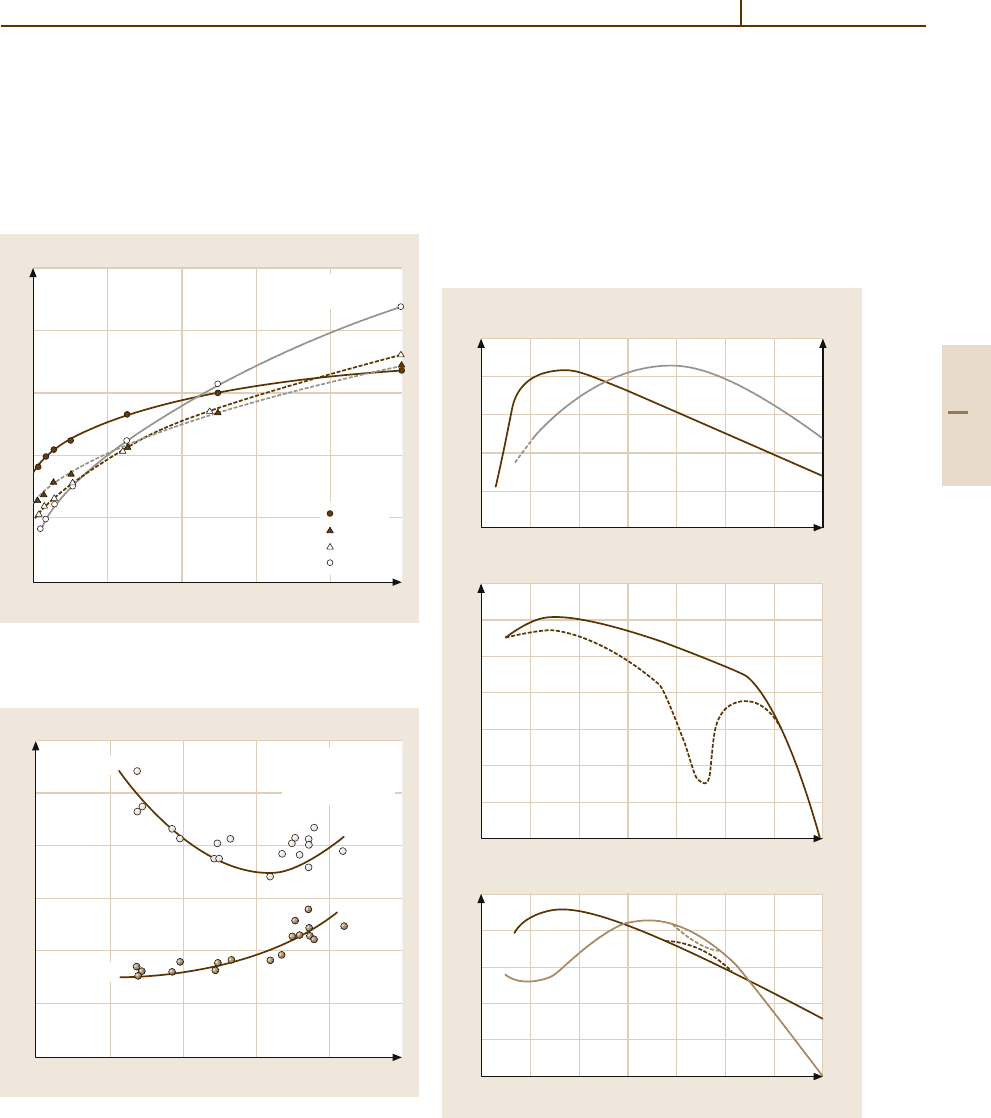
Magnetic Materials 3.2 Soft Magnetic Alloys 769
lowed by rapid cooling to restrain D0
3
type ordering,
large-grain-sized, recrystalllized (100) 0vw textured
material with good ductility and good soft magnetic
properties is obtained, as characterized in Tables 4.3-19
and 4.3-20. Figures 4.3-8 and 4.3-9 show the loss behav-
ior as a function of magnetizing frequency and ribbon
thickness.
50
40
30
20
10
0
04 8121620
f (kHz)
20 µm
40 µm
60 µm
90 µm
Fe–6.5 wt% Si
B= 0.8 T
(×10
–3
Jkg
–1
)P/f
Fig. 4.3-8 Power loss per cycle vs. magnetizing frequency
for rapidly quenched Fe–6.5 wt% Si ribbons of various
thicknesses [3.7]
0.6
0.5
0.4
0.3
0.2
0.1
0
0 20 40 60 80 100
d (µm)
P
d
P(Wkg
–1
)
Fe–6.5 wt % Si
B = 1.25 T
f = 50 Hz
P
P
d
Fig. 4.3-9 Total and dynamic loss at 1.25 T peak induction
and 50 Hz vs. ribbon thickness for rapidly quenched Fe–
6.5 wt% Si ribbons characterized by a strong (100) [0uv]
grain texture induced by vacuum annealing [3.7]
4.3.2.4 Nickel–Iron-Based Alloys
The fcc phase in the Ni
−
Fe alloy system and the for-
mation of the ordered Ni
3
Fe phase provide a wide range
of structural and magnetic properties for developing
soft magnetic materials with specific characteristics for
different applications. The phase diagram is shown in
Sect. 3.1.5. Before amorphous and nanocrystalline soft
magnetic alloys were introduced, the Ni
−
Fe materials
2.0
1.6
1.2
0.8
0.4
0
750
600
450
300
150
0
0 40 60 80 100
2
1
0
–1
–2
–3
–4
–5
0 40 60 80 100
0 40 60 80 100
40
20
0
–20
–40
–60
Saturation polarization
J
s
ˆ
(T)
T
c
Curie temperature
T
c
(°C)
J
s
Crystalline anisotropy K
1
(kJ m
–3
)
Ni content (wt %)
Ni content (wt %)
Disordered
Ordered
Ni content (wt %)
Magnetostriction
(10
–6
)
λ
λ
111
λ
100
Fig. 4.3-10 The dependence of the intrinsic magnetic
parameters I
s
, T
c
, K
1
, λ of Ni
−
Fe alloys on the Ni concen-
tration [3.12]
Part 4 3.2
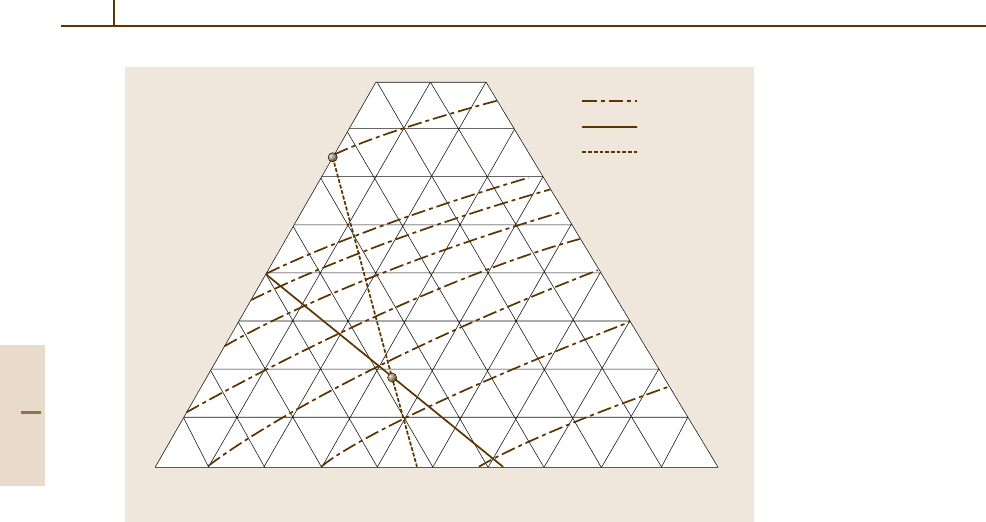
770 Part 4 Functional Materials
0481216 2428323640
θ
= konst.
K
1
= 0
λ
s
= 0
Ni (%)
Me (%)
–273 °C–273 °C
–273 °C
100 °C100 °C
100 °C
200 °C200 °C
200 °C
300 °C300 °C
300 °C
400 °C400 °C
400 °C
500 °C500 °C
500 °C
Fe (%)
λλ
λ
ss
s
0 0
0
K
1
0K
1
0
K
1
0
K
1
= 0K
1
= 0
K
1
= 0
λλ
λ
ss
s
= 0= 0
= 0
λλ
λ
ss
s
00
0
K
1
K
1
K
1
00
0
λλ
λ
ss
s
00
0
K
1
K
1
K
1
00
0
λλ
λ
ss
s
0 0
0
K
1
0K
1
0
K
1
0
λ
=0
=1=1
=1
µµ
µ
B
µµ
µ
K=0
=0=0
=0
µµ
µ
BB
B
µµ
µ
600 °C600 °C
600 °C
θθ
θ
=RT=RT
=RT
Fig. 4.3-11 Zero lines
for K
1
= 0andλ
s
= 0
in the Ni
−
Fe
−
Me sys-
tem [3.14,15]
containing about 72 to 83 wt% Ni with additions of Mo,
Cu, and/or Cr were the magnetically softest materials
available.
Based on the low magnetocrystalline anisotropy K
1
and low saturation magnetostriction λ
s
, the alloys con-
taining about 80 wt% Ni where K
1
and λ
s
pass through
zero attain the lowest coercivity H
c
≈0.5Am
−1
and the
highest initial permeability µ
i
≈ 200 000. Figure 4.3-10
shows the variation of the decisive intrinsic magnetic
parameters I
s
, T
c
, K
1
, λ
100
,andλ
111
of binary Ni
−
Fe
alloys with the Ni concentration. The strong effect of
structural ordering on the magnitude of K
1
should be
noted because it permits control of this intrinsic mag-
netic property by heat treatment.
In the binary Ni
−
Fe system, K
1
= 0 at about
76 wt% Ni and λ
s
= 0 at about 81 wt% Ni. Small ad-
ditions of Cu lower the Ni content for which λ
s
= 0
while Mo additions increase the Ni content for K
1
= 0.
Thus different alloy compositions around 78 wt% Ni are
available which have optimal soft magnetic properties.
General relations of the effect of alloying elements in
Ni
−
Fe-based alloys on K
1
, λ
s
, and on the permeability
have been developed in [3.14,15]. Figure 4.3-11 shows
the position of the lines for K
1
= 0 and λ
s
= 0 in the dis-
ordered Ni
−
Fe
−
Me system, where Me = Cu, Cr, Mo,
W, and V. High permeability regions in the Ni
−
Fe
−
Me
system with a different valence of Me are delineated in
Fig. 4.3-12.
The main fields of application of high permeability
Ni
−
Fe alloys are fault-current circuit breakers, LF and
HF transformers, chokes, magnetic shielding, and high
sensitivity relays.
It should be noted that annealing treatments in
a magnetic field of specified direction induce atomic
rearrangements which provide an additional anisotropy
termed uniaxial anisotropy K
u
. It can be used to mod-
ify the field dependence of magnetic induction in such
a way that the hysteresis loop takes drastically different
forms, as shown in Fig. 4.3-13.
The extremes of a steep loop (Z type) and a skewed
loop (F type) are obtained by field annealing with the
direction of the field (during annealing) longitudinal
and transverse to the operating field of the product, re-
spectively. Materials with Z and F loops produced by
magnetic field annealing are used in magnetic ampli-
fiers, switching and storing cores, as well as for pulse
and instrument transformers and chokes.
Combined with small alloy variations, primary treat-
ments and field annealing treatments, a wide variety
of annealed states can be realized to vary the induc-
tion behavior. The field dependence of the permeability
of some high-permeability Ni
−
Fe alloys (designations
according to Vacuumschmelze GmbH) are shown in
Fig. 4.3-14 [3.16].
Alloys of Ni
−
Fe in the range of 54–68 wt% Ni com-
bine relatively high permeability with high saturation
Part 4 3.2
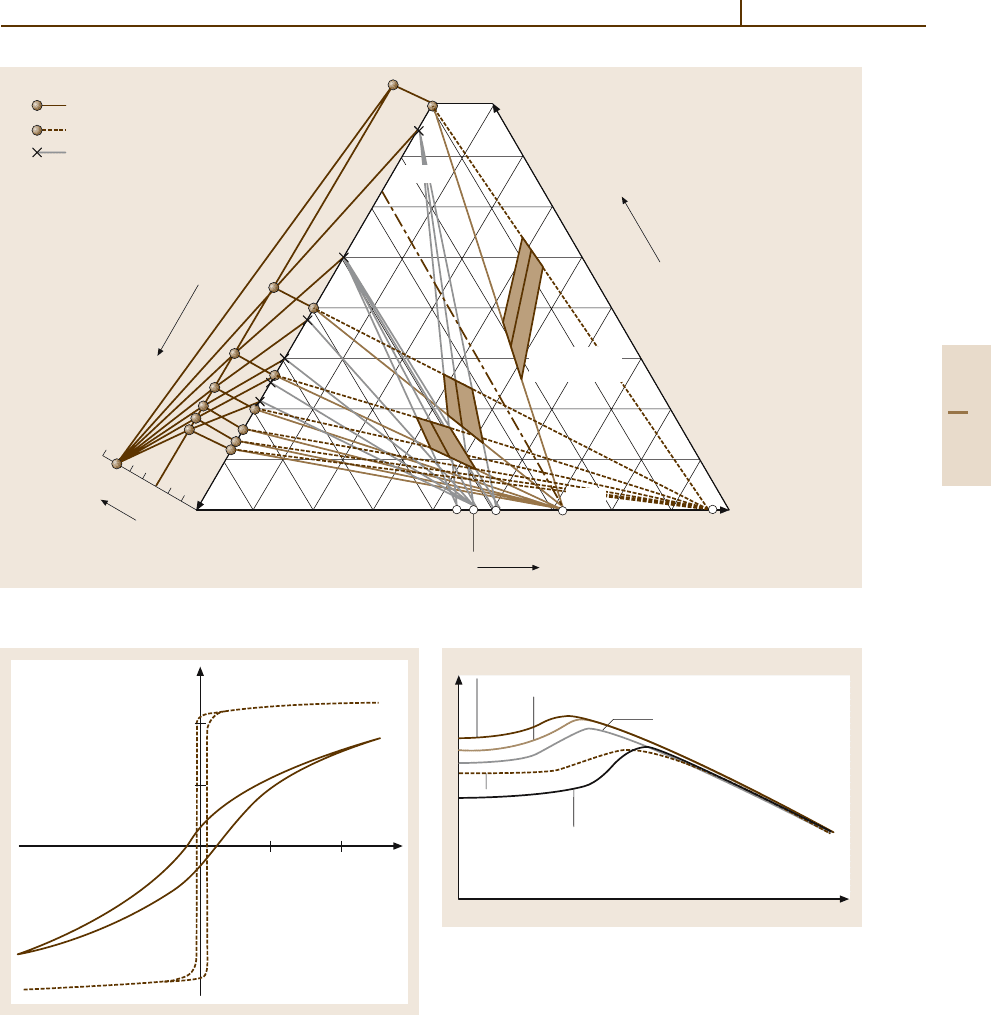
Magnetic Materials 3.2 Soft Magnetic Alloys 771
λ
s
= 0
6868
68
32
7272
72
28
7676
76
24
8080
80
20
8484
84
16
8888
88
12
8
9292
92
9696
96
4
0
4 8 12 16 24 28 32 36
0.6
0.4
0.2
Ni
Me (at.%)
Fe (at.%)
Ni (at.%)
Magn.
moment ( )
K
1
= 0 disordered
B
µ
K
1
= 0 ordered
disordered
and ordered
λ
100
= 0
K
1
= 0K
1
= 0
λ
s
= 0
λ
m
= 0
Ni
3
FeNi
3
Fe
Ni
3
Fe
VIIVII
VII
VIVI
VI
VV
V
IVIV
IV
IIIIII
III
IIII
II
II
I
High-perme-High-perme-
High-perme-
ability regionability region
ability region
NiNi
Ni
33
3
FeFe
Fe
Fig. 4.3-12 Schematic representation of high-permeability regions in the ternary system Ni
−
Fe
−
Me by means of the
zero curves K
1
, λ
100
= 0andλ
111
= 0 for additives with valence I–VIII [3.15]
1.0
0.5
H (A/m)
B (T)
Z
50 100
Transverse
field annealed
Longitudinal
field annealed
F
Fig. 4.3-13 Alloy of the 54–68 wt% NiFe-group with
Z- and F-loop [3.12]
polarization. Magnetic field annealing of these alloys
provides a particularly high uniaxial anisotropy with
ensuing Z and F type loops [3.12].
Alloys containing 45 to 50 wt% Ni reach maximum
saturation polarization of about 1.6 T. Under suitable
0
µ
a
H
Ultraperm 200
Ultraperm 10
Vacoperm 100
Vacoperm BS
Mumetall
Fig. 4.3-14 Permeability versus field strength for high
permeability high Ni-content Ni
−
Fe-alloys of Vacuum-
schmelze Hanau
rolling and annealing conditions a cubic texture with
an ensuing rectangular hysteresis loop and further loop
variants over a wide range can be realized. The mi-
crostructure may vary from fine grained to coarsely
grained.
Alloys containing 35 to 40 wt% Ni show a small
but constant permeability, µ
r
= 2000–8000, over
a wide range of magnetic field strength. Moreover,
Part 4 3.2
